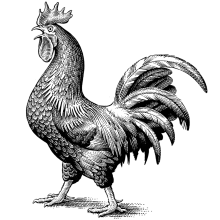Chanticleer

Chanticleer is Australia’s pre-eminent business column.
Ross McEwan has an army of economists and thousands of data points to tell him how bad the economy is suffering from the COVID-19 shutdown. But it’s the conversations he’s been having with business people that have been most telling.
“One day they’re running a business and the next day their income’s completely stopped,” McEwan tells Chanticleer.
National Australia Bank’s boss Ross McEwan is racing to get ahead of the COVID-19 hit. David Rowe
“It was a very clear signal that we’ll win when our customers win, and when they’re not, we should be taking some of the pain with them.”
McEwan, his leadership team and his board will personally feel that pain, after taking pay cuts of 20 per cent and cancelling bonuses.
But on Monday, it also fell to McEwan to remind Australian investors that they can’t escape the grim new reality facing the banking sector.
The NAB chief executive and his fellow bank CEOs have been pillars of strength during the crisis, acting quickly and decisively to reassure customers and the broader community that the banks will do their bit to get the economy through this crisis.
But in a shock set of announcements made 11 days before NAB was due to release its results for six months ended March 31, McEwan sought to show shareholders he has acted quickly and decisively to ensure the bank can bear the pain it’s facing, and come out the other side in good shape.
Having delivered a 51.3 per cent fall in interim profit, NAB announced it will raise $3 billion from institutions via a placement, and up to $500 million from retail shareholders.
And then came the kicker – NAB will slash its interim dividend from 83¢ last year to just 30¢.
While banks profit results are typically very carefully staged managed, it’s clear that McEwan and NAB chairman Phil Chronican have preferred speed to finesse in trying to get ahead of what they see coming.
Their conversations with customers – a staggering 650,000 business and retail customers have now called NAB asking for assistance – have helped inform the bank’s scenario planning at to the level of losses it may see in the coming period.
Three key metrics
McEwan says bad debts aren’t rising yet, but the three big factors to watch are GDP growth, unemployment and house prices.
NAB’s base case calls for the economy to contract by 3 per cent during 2020, as unemployment spikes to 11.6 per cent and house prices slip 10 per cent.
But it is worth noting that the $807 million provision it has taken to reflect the possible pain of COVID-19 is actually more than double what it needed to take under that base case.
As such, that $807 million provision reflects at least a bit of its “severe downside” scenario, which predicts that instead of GDP bouncing back in 2021 by 3.4 per cent under the bank’s base case, the economy contracts by 2.5 per cent, with unemployment staying around 10 per cent that year, and house prices tumbling further.
McEwan says it is simply impossible to determine exactly what the shape of the economic recovery will be, which is why he’s beaten his rivals to go to the market to try and future-proof the bank’s balance sheet.
The combination of the $3.5 billion capital raising and the 66 per cent cut in the dividend will take NAB’s tier 1 capital ratio from 10.38 per cent at September 30 last year to 11.2 per cent.
“We want to stay strong even through a U-shaped recovery,” McEwan says. “You usually find that banks that have a very strong position come out best and that’s what I want to position this for.”
‘It was a balancing act’
While investors will be bleeding at the double blow of being diluted via a capital raising and seeing their precious dividend cut, there is something incongruous about retaining even part of the dividend given the need to buttress the balance sheet.
UBS analyst Jonathan Mott was quick to “question paying a dividend to shareholders while simultaneously raising $3.5 billion in fresh equity” when NAB shares are trading below their tangible book value.
McEwan said the board has tried to balance competing priorities, particularly the fact almost half of NAB’ shareholder base are mum and dad investors.
So even with the Australian Prudential Regulation Authority warning the banks to prefer capital strength to dividend payouts, McEwan and Chronican have decided that it is better to retain some level of payout to keep these retail investors sweet.
Protecting NAB’s share price during the capital raising would have also been a key consideration; imagine where the NAB shares (which are in a trading halt until Tuesday) would trade on the back of a dilutive capital raising as well as the complete abandonment of the interim dividend.
“Forty-eight per cent of our shareholders are retail. We don’t want them running out the door at the same time we’re doing a capital raise,” McEwan said bluntly. “So it was a balancing act.”
That’s a nice way of describing that McEwan is trying to more broadly here – using different levers to try to balance the short-term needs of the bank’s customers with the longer-term vision he has for the bank.
With the economic outlook nearly impossible to predict, McEwan will adjust provisions and dividends each six months to reflect changing circumstances. But the $3.5 billion capital raising is designed to ensure NAB can withstand even its worst-case scenario.
The question for bank investors is what NAB’s rivals do now, particularly in getting that balance between dividends and raising capital.
The fall in bank stocks on Monday – Westpac down more than 4 per cent, ANZ down 3.1 per cent and Commonwealth Bank down 2.2 per cent – suggests more pain is likely.
How the coronavirus is changing markets, business and politics.
Coronavirus: Need to know. Our daily reporting, in your inbox.







